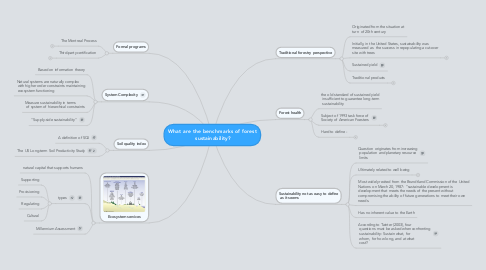
1. Traditional forestry perspective
1.1. Originated from the situation at turn of 20th century
1.2. Initially, in the United States, sustainability was measured as the success in repopulating a cut-over site with trees
1.2.1. Virgin longleaf
1.2.2. Cut-over longleaf
1.2.3. Regenerated
1.3. Sustained yield
1.4. Traditional products
1.4.1. Wood
1.4.2. Water
1.4.3. Wildlife
1.4.4. Recreation
2. Forest health
2.1. the old standard of sustained yield insufficient to guarantee long-term sustainability
2.2. Subject of 1993 task force of Society of American Foesters
2.2.1. Does not ensure integrity of system
2.2.2. Does not satisfy desire intangible or values without market value
2.2.3. Subject to greater social constraints
2.3. Hard to define -
2.3.1. matter of perspective
2.3.2. Gray Reynolds, deputy chief of the USDA Forest Service proposed that "Forest health is a condition of forest ecosystems that sustains their complexity with providing for human needs."
3. Formal programs
3.1. The Montreal Process
3.1.1. Origin
3.1.1.1. International, nonbinding agreement among 12 nations
3.1.1.2. 1992 UN Conference on Environment and Development (The Earth Summit)
3.1.1.2.1. Outline of sustainable forest management
3.1.1.2.2. Need to combat deforestation
3.1.2. Set of criteria and indicators
3.1.2.1. Conservation of biological diversity
3.1.2.2. Maintenance of productive capacity of forest ecosystems
3.1.2.3. Maintenance of forest ecosystem health and vitality
3.1.2.4. Conservation and maintenance of soil and water resources
3.1.2.5. Maintenance of forest contribution to global carbon
3.1.2.6. Maintenance and enhancement of long-term multiple socioeconomic benefits to meet the demands of societies
3.1.2.7. Legal, policy, and institutional network
3.1.3. Latest US report - 2010
3.1.3.1. Amount of forest land is stable
3.1.3.2. Fragmentation and loss occurring mostly from human development
3.1.3.3. Services demanded from forests rising
3.1.3.4. Forest disturbance rising, 3-fold increase in insect-induced mortality since 2004
3.1.3.5. Wood products production declining relative to consumption, imports making up difference
3.1.3.6. Forest Management activity declining as firms divest of timber lands
3.1.3.7. Capacity and willingness to manage forests even; growing number of public-private collaborations at landscape scales
3.2. Third-party certification
3.2.1. Company or agency level
3.2.2. Forest Stewardship Council
3.2.2.1. "The Forest Stewardship Council mission is to promote environmentally sound, socially beneficial and economically prosperous management of the world's forests".
3.2.2.2. Judge subscribers according to 10 principles and 57 criteria
3.2.2.3. Leads to FSC certification
3.2.3. Sustainable Forestry Initiative
3.2.3.1. Began in 1994 by US forest industry after the Earth Summit in 1992
3.2.3.2. 14 principles, 20 objectives, 38 performance measures, and 115 indicators
4. System Complexity
4.1. Based on information theory
4.2. Natural systems are naturally complex with higher order constraints maintaining ecosystem functioning
4.3. Measure sustainability in terms of system of hierarchical constraints
4.4. "Supply-side sustainability"
5. Soil quality index
5.1. A definition of SQI
5.2. The US Long-term Soil Productivity Study
6. Ecosystem services
6.1. natural capital that supports humans
6.2. types
6.2.1. Supporting
6.2.2. Provisioning
6.2.3. Regulating
6.2.4. Cultural
6.3. Millennium Assessment
7. Sustainability not as easy to define as it seems
7.1. Question originates from increasing population and planetary resource limits
7.2. Ultimately related to well being
7.2.1. Components
7.2.1.1. Security
7.2.1.2. Basic material for good life
7.2.1.3. Health
7.2.1.4. Good social relations
7.2.1.5. Freedom of choice
7.2.2. Environmental justice
